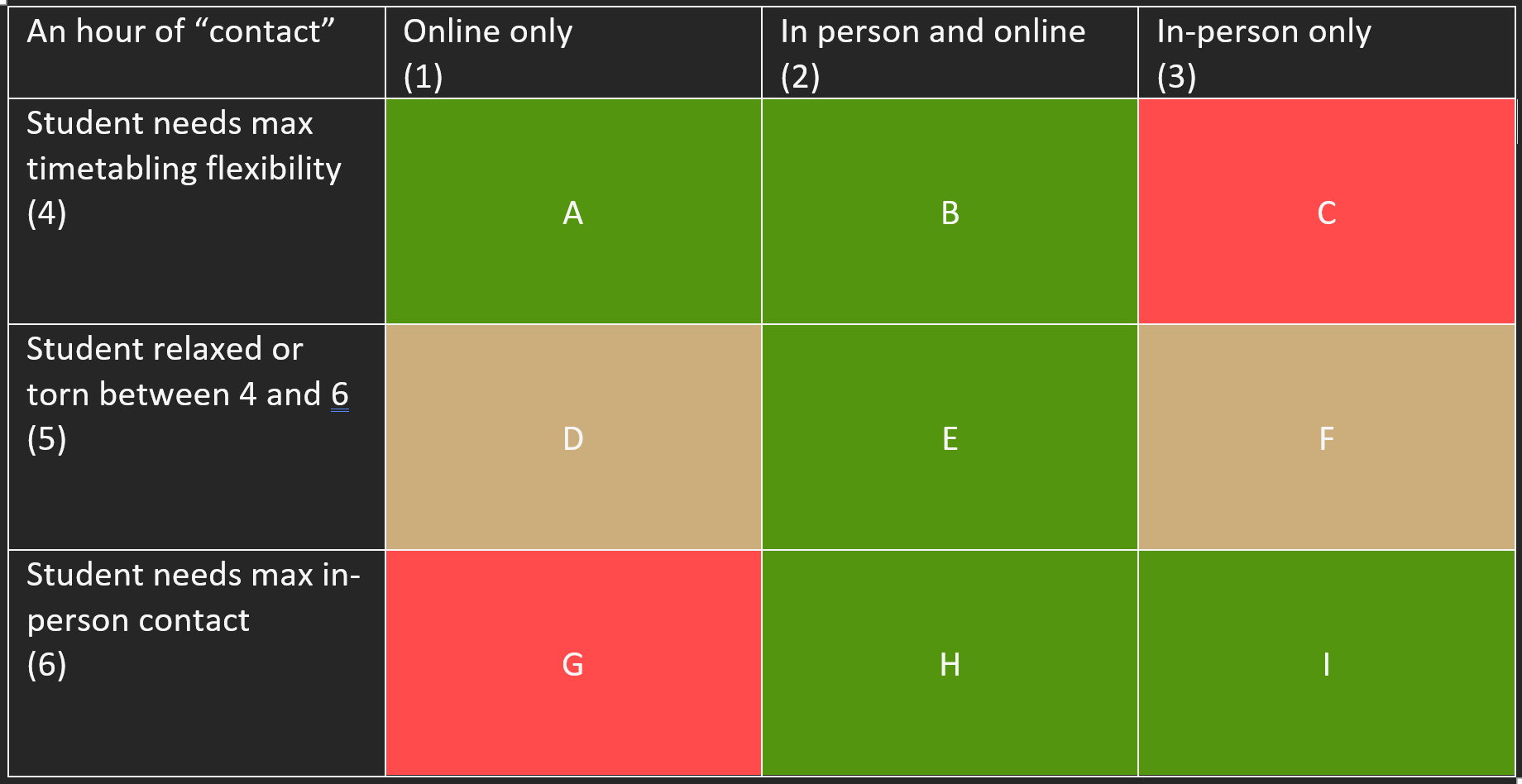Last year’s rare rail journeys produced a back-of-a-fag-packet scribble that helped a few people think about the student experience being planned for September rather than just the “provision”.
A much better model was this one from Jo Walters from 25 Dots who was trying to help us to understand what a socially distant student experience would be like.
With blended learning in the news and on the minds of many a meeting, lots of conversations and several hours on trains have got me to here. And yes, I know, extra resources are part of “blended”, and it’s also true that students’ learning was already “blended” pre-pandemic.

This isn’t hugely original thinking and nor is it the proverbial “rocket science”, but hopefully it helps a few think through some of the bigger issues and tensions in play as preparation continues for September.
If you have thoughts or comments, do drop them below.
Hours of contact
The unit here is the “contact hour”. These matter because the volume of them appears to be correlated to satisfaction, perceptions of value, and mental health.
Clearly not all “Column 2” hours are the same. Genuine simultaneous live in-person and online teaching is really hard to do well. Lots of (2) is really live teaching with a recording – and for many students that’s great, although not interactive for those relying only on the recording.
The promises made at the pre-contract stage along the top row matter. If 1 becomes 2, or 3 becomes 2, that’s fine – it’s a bonus. But if 1 becomes 3 or 3 becomes 1, that’s a broken promise.
In the event of 3s becoming 1s or 1s becoming 3s, merely giving students notice now and the opportunity to not re-enrol is likely to be a fail in consumer law terms because the consumer can’t easily walk away and switch.
“Away from home” students probably have a housing contract already. “Commuter students” may not be able to attend any other uni at all. So the duty to perform as per the pre-contract info is strong. See here for a summary of that legal position.
Some Column 3 hours became Column 1 hours during the pandemic on heavily practical courses, and lots of students are still hopping mad about it – because while “the learning outcomes have been met” students lack the confidence to do the thing the hour was supposed to help them to be able to do.
When students say they want “blended”, most are saying they want as many column 2 hours as possible. There’s a vanishingly small number of students who “mean” a mixture of 1 and 3. Nuts and gum in a bag isn’t a “blend”, it’s a nightmare.

Value
We do have to accept that just as folks don’t value a DVD like they do the theatre, students don’t value column A as much as column C, even if column A was harder or more expensive to produce! That’s partly because of the attraction of live theatre and partly because of the social aspects of pre and post the contact hour.
The reason that matters a lot is that if the gulf in experience between two courses, both of which are charged at £9,250 home and £20,000 international, becomes too large in terms of the mix of in-person and online, the already stretched acceptance of a universal fee where cross subsidies occur just snaps.

A hell of a lot of returning “away from home” students now associate Column 1 with loneliness and poor levels of motivation. They really bloody hate Column 1 in the context of last year and the restrictions.
I can’t stress enough even to people who were students five years ago how awful and tiny and squeezed and poor quality and miserable student accomm often is. If not, it’s expensive. Or both. What you wouldn’t want to do is spend weeks on end in any of it, and that is also now associated with Column 1.
There are differences in value perception of different activity within Column 2 based on whether you’re a (4), (5) or (6) student. Recorded lectures that can’t be seen in-person are not usually seen in same way as live face-to-face teaching by (5) and (6) students, despite huge effort to produce the materials, and despite students saying they like the accessibility / flexibility etc. It seems live things are seen as “contact”, but pre-recorded lectures are seen as a “resource”.
Any reduction in total “contact” is likely to be viewed negatively, and for (5) and (6) students moved towards online only for contact will also be viewed negatively. Hence any hours that move from “live in person” to “pre-recorded online only resource” get a double whammy of negativity.
Flexibility
Obviously we should do all we can to shift contact hours into Column 2 if we can, but that may not be possible and may be expensive.
There were always Row 4 students who really needed some Column 2 and mainly Column 1, but who we forced onto campus. That’s partly because of the gravitational pull of the campus UG experience, the decline of mature students etc
If there are really strong needs in Row 4 we have to accept that most courses now are “in person” courses according to funding rules. We may not be able to make a course that meets the needs of Row 4 students.
We’ve come to realise how important the “need” is at Row 6, but only because the contact got taken away. We mustn’t dismiss it now, especially towards the start of a student’s journey – for undergraduates, the first half of the first year is hugely “Row 6” important.
Box G is a box that’s chock full of anger, and feelings of being let down, and very bad press.

As I conclude with here, real “blended” would mean bursts of time in Column 3 and then lots of Column 1 with options for on-campus activity. The professional PGT block teaching model, but for UGs.
It would be great, and would suit the new breed of regionally recruited students who live too far away for an easy commute and too close to justify rental accommodation. But we’d need time and transformation to timetables, student services, SUs, funding rules and so on. We can’t get there by September 2021.
In terms of the needs of students, a huge number of previously (5) students have become (6) students. A global pandemic and several lockdowns will do that to you.
Similarly, a recession, kids being off school, work being difficult, a long commute and so on will also have pushed some students from (5) students to (4) students.
Without a lot of Column 2 provision, I’m not convinced the actual needs of (4)s and (6)s are reconcilable.
To take an example – if a university’s humanities faculty is proposing “online only lectures and in-person not recorded seminars”, that’s what I’d call a “nuts and gum” programme. The two ingredients don’t really blend and end up pleasing very few people – because large swathes of previously (5) students are now (6) or (4).
What’s going on?
Finally. Some switching of Column 3 to Column 1 isn’t really about being blended or flexible or safety.

It’s about a) being able to bank international students fees that haven’t arrived yet, and b) being able to exceed the size of current lecture theatres in what’s set to be a bumper recruitment year.
I can’t stress enough how badly it will go down if the bits of the sector that are doing lots of 3-to-1 switching aren’t honest about why. People will work it out.



















